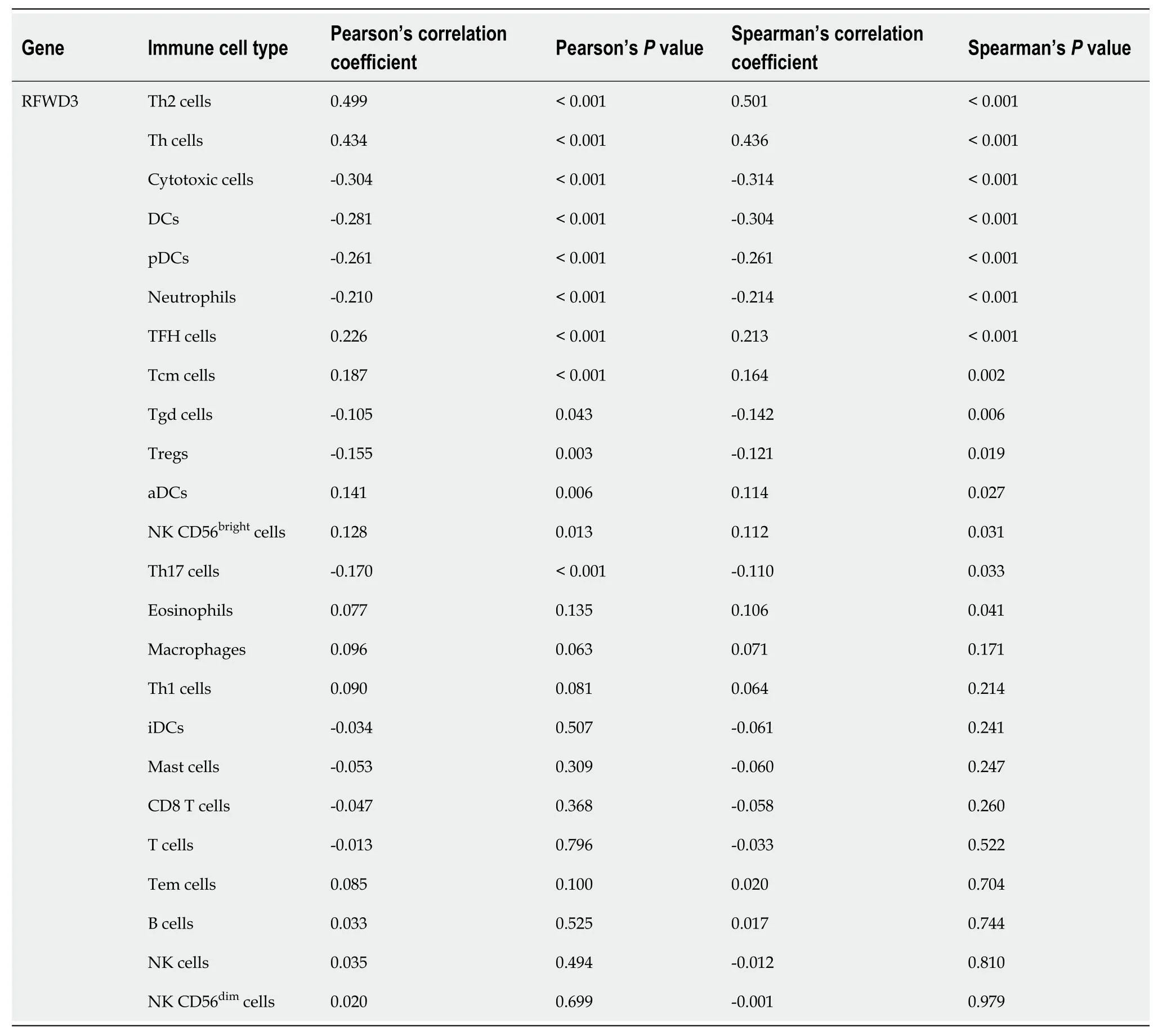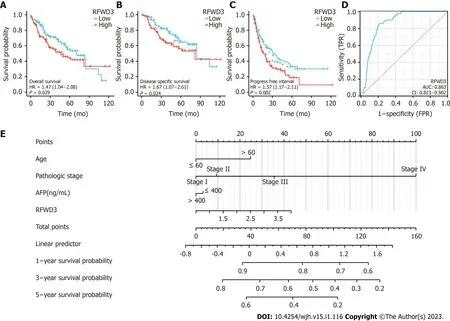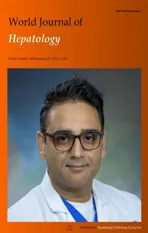Prognostic role of ring finger and WD repeat domain 3 and immune cell infiltration in hepatocellular carcinoma
2023-03-18YanDongMiaoWuXiaQuanJiangTaoWangJianGanXinDongFangZhang
Yan-Dong Miao,Wu-Xia Quan,Jiang-Tao Wang,Jian Gan,Xin Dong,Fang Zhang
Yan-Dong Miao,Fang Zhang,Cancer Center,Yantai Affiliated Hospital of Binzhou Medical University,Yantai 264000,Shandong Province,China
Wu-Xia Quan,Department of Electrocardiogram,Yantai Affiliated Hospital of Binzhou Medical University,Yantai 264100,Shandong Province,China
Jiang-Tao Wang,Department of Thyroid and Breast Surgery,Yantai Affiliated Hospital of Binzhou Medical University,Yantai 264000,Shandong Province,China
Jian Gan,Department of Gastroenterology,Yantai Affiliated Hospital of Binzhou Medical University,Yantai 264000,Shandong Province,China
Xin Dong,Second Department of Oncology,Yantai Affiliated Hospital of Binzhou Medical University,Yantai 264000,Shandong Province,China
Abstract We have found that the expression of ring finger and WD repeat domain 3 (RFWD3) is significantly higher in unpaired and paired hepatocellular carcinoma(HCC) tissues than in normal tissues.Moreover,this expression has a significant correlation with the infiltration level of 14 immune cell types and when the detected RFWD3 expression levels were grouped as high and low,a prominent difference was revealed for overall survival,disease-specific survival,and progression-free interval.Through statistical analysis (univariate Cox),we were also able to identify RFWD3 as an independent prognostic element for HCC,with RFWD3 having an ability to accurately predict HCC prognosis (area under the curve of 0.863).Finally,we have generated prognostic nomograms for probabilities of 1-,3- and 5-year overall survival in HCC via integrating the factors of age,pathologic stage,alpha-fetoprotein level,and RFWD3 expression.
Key Words: Hepatocellular carcinoma;Ring finger and WD repeat domain 3;Immune cell infiltration;Bioinformatics
TO THE EDITOR
We perused the recently published paper by Lianget al[1] with much interest.The authors reported on their assessments of ring finger and WD repeat domain 3 (RFWD3) expression levels in hepatocellular carcinoma (HCC) patients.Their findings included RFWD3 effects on HCC prognosis,the processes of proliferation,invasion and metastasis,and the underlying mechanisms,specifically regulationviathe Wnt/β-catenin signaling pathway.We have a particular appreciation for these authors' novel investigation into the prognostic implication of RFWD3 in HCC as we have also discovered that the expression of RFWD3 is prominently higher in both unpaired and paired HCC tissues from HCC patients than in their corresponding normal tissues (Figure 1A and B).
According to the current literature,cancer cells,endothelial cells,stromal cells,immune cells,and cancer-associated fibroblasts cells all exist in the tumor microenvironment (TME)[3,4].While the TME is known to play crucial roles in development,invasion and metastasis of HCC,the immune escape of HCC cells has yet to be fully understood and continues to complicate cancer treatment[5].Due to the ongoing and well-known limitations of chemotherapy in general,immunotherapies are a hot topic of bench and clinical research.This newly emerging cancer therapy exploits immune cells both inside and outside the TME to target and attack cancer cells;its demonstrated advantages are high specificity and low side-effects[6].The power of this therapeutic method’s potential lies in the fact that different types of immune-related cells serve diverse roles;for HCC,the research into defining and developing those immune cells that inhibit/promote tumor processes has a long way to go[7].
Upon reading the report that Lianget al[1] found RFWD3 is able to affect the prognosis of HCC,we tested a hypothesis that the expression of RFWD3 may be associated with immune cell infiltration in HCC.Detailed information is shown in Table 1.Following our initial positive data,we systematically explored the correlation between RFWD3 expression and infiltration level of 24 immune cell types,using a single-sample gene set analysis (also known as ssGSEA) algorithm and Spearman coefficient correlation analysis[8].We found that RFWD3 expression has a remarkable correlation with the infiltration level of 14 immune cell types (Figure 2A).Among them,RFWD3 expression was positively associated with the infiltration level of T helper (Th) cells in general,Th2 cells in particular,T follicular helper (TFH) cells,T central memory (Tcm) cells,activated dendritic cells (DCs),natural killer (NK)CD56brightcells,and eosinophils ( allP<0.05;Figure 2B-H).There were negative associations with cytotoxic cells,DCs,plasmacytoid DCs (pDCs),neutrophils,T gamma delta (Tgd) cells,T regulatory cells (Tregs),and Th17 cells (allP<0.05;Figure 2I-O).We hope our findings will encourage further investigations into RFWD3 as an HCC immunotherapy.Detailed information on this aspect is presented in Table 2.
Importantly,we agree with the finding of Lianget al[1] that indicates higher RFWD3 expression is related to worse overall survival (OS) in HCC.We have found that OS,disease-free survival,and progression-free interval were prominently shorter in HCC patient tissues with high RFWD3 expression than in those with low RFWD3 expression (allP<0.05;Figure 3A-C).Our further statistical analysisviaunivariate Cox regression identified RFWD3 as an independent prognostic element for HCC (Table 3).Generation of the receiver operating characteristic curve showed that RFWD3 has the ability to accurately predict prognosis in HCC (area under the curve of 0.863).Finally,we generated prognostic nomograms for probabilities of 1-,3- and 5-year OS in HCCviaintegrating the factors of age,pathologic stage,alpha-fetoprotein level,and RFWD3 expression;each element was assigned a score according to its contribution to survival (Figure 3E).
Ultimately,our new findings highlight that the research of Lianget al[1] is worthy of attention and that subsequent efforts to build upon it,such as our related discoveries,may promote the next generation of effective and safe therapeutics,such as immunotherapies.

Table 1 Detailed statistical results of differential expression of ring finger and WD repeat domain 3 in hepatocellular carcinoma and normal tissues

Table 2 Detailed information on the statistical correlation between ring finger and WD repeat domain 3 expression and immune cell infiltration
Statistical analysis
R statistical software (version 4.1.2;R Foundation for Statistical Computing,Vienna,Austria;https://www.R-project.org/) was used for all statistical analyses.Wilcoxon rank-sum test was used to perform the differential expression analysis of RFWD3 between HCC samples and corresponding normal samples,with results demonstrated by the “ggplot2” R package[10].Survival analysis was carried out by log-rank test and univariate Cox regression.The association between RFWD3 expression and immune cell infiltration were performed by Spearman and Pearson analysis.Positive values of correlation coefficient indicate positive correlation,negative values indicate negative correlation.

Table 3 Univariate Cox regression analysis in hepatocellular carcinoma

Figure 1 Differential expression levels of ring finger and WD repeat domain 3 in hepatocellular carcinoma and normal tissues.

Figure 2 Correlation analysis of ring finger and WD repeat domain 3 expression and immune cell infiltration in hepatocellular carcinoma.

Figure 3 Survival analysis of ring finger and WD repeat domain 3 in hepatocellular carcinoma and the nomogram for prognosis.
FOOTNOTES
Author contributions:Miao YD and Zhang F designed the research;Miao YD wrote the paper;Quan WX and Wang JT performed the data analysis,Gan J and Dong X prepared the tables and figures;Zhang F and Miao YD reviewed the manuscript;Miao YD and Quan WX contributed equally to the article;All authors approved the final manuscript.
Conflict-of-interest statement:All the authors report having no relevant conflicts of interest for this article.
Open-Access:This article is an open-access article that was selected by an in-house editor and fully peer-reviewed by external reviewers.It is distributed in accordance with the Creative Commons Attribution NonCommercial (CC BYNC 4.0) license,which permits others to distribute,remix,adapt,build upon this work non-commercially,and license their derivative works on different terms,provided the original work is properly cited and the use is noncommercial.See: https://creativecommons.org/Licenses/by-nc/4.0/
Country/Territory of origin:China
ORCID number:Yan-Dong Miao 0000-0002-1429-8915;Wu-Xia Quan 0000-0002-1898-850X;Jiang-Tao Wang 0000-0002-1222-164X;Jian Gan 0000-0003-2645-6076;Xin Dong 0000-0002-4318-3228;Fang Zhang 0000-0001-5120-0991.
S-Editor:Xing YX
L-Editor:Filipodia
P-Editor:Xing YX
杂志排行
World Journal of Hepatology的其它文章
- Liver immunity,autoimmunity,and inborn errors of immunity
- Clinical characteristics and outcomes of COVID-19 in patients with autoimmune hepatitis: A population-based matched cohort study
- Influence of non-alcoholic fatty liver disease on non-variceal upper gastrointestinal bleeding: A nationwide analysis
- Rising incidence,progression and changing patterns of liver disease in Wales 1999-2019
- Detection of colorectal adenomas using artificial intelligence models in patients with chronic hepatitis C
- Acute-on-chronic liver failure in patients with severe acute respiratory syndrome coronavirus 2 infection
